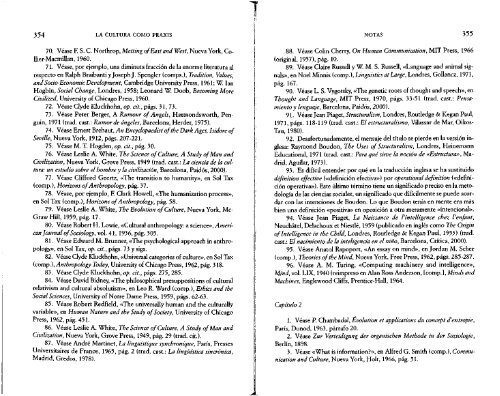Zygmunt Bauman La cultura como praxis
Zygmunt Bauman La cultura como praxis
Zygmunt Bauman La cultura como praxis
Create successful ePaper yourself
Turn your PDF publications into a flip-book with our unique Google optimized e-Paper software.
1<br />
354 LA CULTURA COMO PRAXIS NOTAS 355<br />
70. Véase F. S. C. Northrop, Metting ofEast and West, Nueva York, Collier-Macmillan,<br />
1960.<br />
71. Véase, por ejemplo, una diminuta fracción de la enorme literatura al<br />
respecto en Ralph Braibanti yjoseph J. Spengler (comps.), Tradition, Valúes,<br />
andSocio-EconomicDevelopment, Cambridge University Press, 1961; W. lan<br />
Hogbin, Social Change, Londres, 1958; Leonard W. Doob, Becoming More<br />
Civilized, University of Chicago Press, 1960.<br />
72. Véase Clyde Kluckhohn, op. cit., págs. 31, 73.<br />
73. Véase Peter Berger, A Rumour of Angels, Harmondsworth, Penguin,<br />
1971 (trad. cast.: Rumor de ángeles, Barcelona, Herder, 1975).<br />
74. Véase Ernest Brehaut, An Encyclopaedist ofthe Dark Ages, Isidore of<br />
Seville, Nueva York, 1912, págs. 207-221.<br />
75. Véase M. T. Hogden, op. cit., pág. 30.<br />
76. Véase Leslie A. White, The Science of Culture, A Study o/Man and<br />
Civilization, Nueva York, Grove Press, 1949 (trad. cast.: <strong>La</strong> ciencia de la <strong>cultura</strong>:<br />
un estudio sobre el hombre y la civilización, Barcelona, Paidós, 2000).<br />
77. Véase Clifford Geertz, «The transition to humanity», en Sol Tax<br />
(comp.), Horizons ofAnthropology, pág. 37.<br />
78. Véase, por ejemplo, F. Clark Howell, «The humanization process»,<br />
en Sol Tax (comp.), Horizons ofAnthropology, pág. 58.<br />
79. Véase Leslie A. White, The Evolution of Culture, Nueva York, Mc-<br />
Graw HUÍ, 1959, pág. 17.<br />
80. Véase Robert H. Lowie, «Cultural anthropology: a science», American<br />
JournalofSociology, vol. 41, 1936, pág. 305.<br />
81. Véase Edward M. Brunner, «The psychological approach in anthropology»,<br />
en Sol Tax, op. cit., págs. 73 y sigs.<br />
82. Véase Clyde Kluckhohn, «Universal categories of culture», en Sol Tax<br />
(comp.), Anthropology Today, University of Chicago Press, 1962, pág. 318.<br />
83. Véase Clyde Kluckhohn, op. cit., págs. 275, 285.<br />
84. Véase David Bidney, «The philosophical presuppositions of <strong>cultura</strong>l<br />
relativism and <strong>cultura</strong>l absolutism», en Leo R. Ward (comp.), Ethics and the<br />
Social Sciences, University of Notre Dame Press, 1959, págs. 62-63.<br />
85. Véase Robert Redfield, «The universally human and the <strong>cultura</strong>lly<br />
variable», en Human Nature and the Study ofSociety, University of Chicago<br />
Press, 1962, pág. 451.<br />
86. Véase Leslie A. White, The Science of Culture, A Study ofMan and<br />
Civilization, Nueva York, Grove Press, 1949, pág. 29 (trad. cit.).<br />
87. Véase André Martinet, <strong>La</strong> linguistique synchronique, París, Presses<br />
Universitaires de France, 1965, pág. 2 (trad. cast.: <strong>La</strong> lingüística sincrónica,<br />
Madrid, Credos, 1978).<br />
88. Véase Colín Cherry, On Human Communication, MIT Press, 1966<br />
(original, 1957), pág. 10.<br />
89. Véase Claire Russell y W. M. S. Russell, «<strong>La</strong>nguage and animal signáis»,<br />
en Noel Minnis (comp.), Linguisticsat<strong>La</strong>rge, Londres, Gollancz, 1971,<br />
pág. 167.<br />
90. Véase L. S. Vygotsky, «The genetic roots of thought and speech», en<br />
Thought and <strong>La</strong>nguage, MIT Press, 1970, págs. 33-51 (trad. cast.: Pensamiento<br />
y lenguaje, Barcelona, Paidós, 2000).<br />
91. Véase Jean Piaget, Structuralism, Londres, Routledge Se Kegan Paul,<br />
1971, págs. 118-119 (trad. cast.: El estructuralismo, Vilassar de Mar, Oikos-<br />
Tau, 1980).<br />
92. Desafortunadamente, el mensaje del título se pierde en la versión inglesa:<br />
Raymond Boudon, The Uses of Structuralism, Londres, Heinemann<br />
Educational, 1971 (trad. cast.: Para qué sirve la noción de «Estructura», Madrid,<br />
Aguilar, 1973).<br />
93. Es difícil entender por qué en la traducción inglesa se ha sustituido<br />
définition effective («definición efectiva») por operational definition («definición<br />
operativa»). Este último término tiene un significado preciso en la metodología<br />
de las ciencias sociales, un significado que difícilmente se puede acordar<br />
con las intenciones de Boudon. Lo que Boudon tenía en mente era más<br />
bien una definición «positiva» en oposición a otra meramente «intencional».<br />
94. Véase Jean Piaget, <strong>La</strong> Naissance de l'intelligence chez l'enfant,<br />
Neuchátel, Delachoux et Niestlé, 1959 (publicado en inglés <strong>como</strong> The Origin<br />
of Intelligence in the Child, Londres, Routledge & Kegan Paul, 1953) (trad.<br />
cast.: El nacimiento de la inteligencia en el niño, Barcelona, Crítica, 2000).<br />
95. Véase Anatol Rapoport, «An essay on mind», en Jordán M. Scher<br />
(comp.), Theories ofthe Mind, Nueva York, Free Press, 1962, págs. 285-287.<br />
96. Véase A. M. Turing, «Computing machinery and intelligence»,<br />
Mind, vol. LIX, 1940 (reimpreso en Alan Ross Anderson, [comp.], Minas and<br />
Machines, Englewood Cliffs, Prentice-Hall, 1964.<br />
Capítulo 2<br />
1. Véase P. Chambadal, Evolution et applications du concept d'entropie,<br />
París, Dunod, 1963, párrafo 20.<br />
2. Véase Zur Verteidigung der organischen Methode in der Soztologie,<br />
Berlín, 1898.<br />
3. Véase «What is information?», en Alfred G. Smith (comp.), Communication<br />
and Culture, Nueva York, Holt, 1966, pág. 51.


